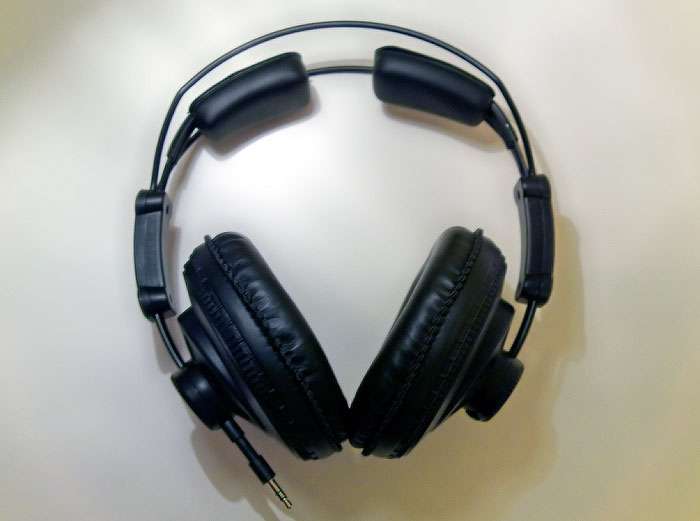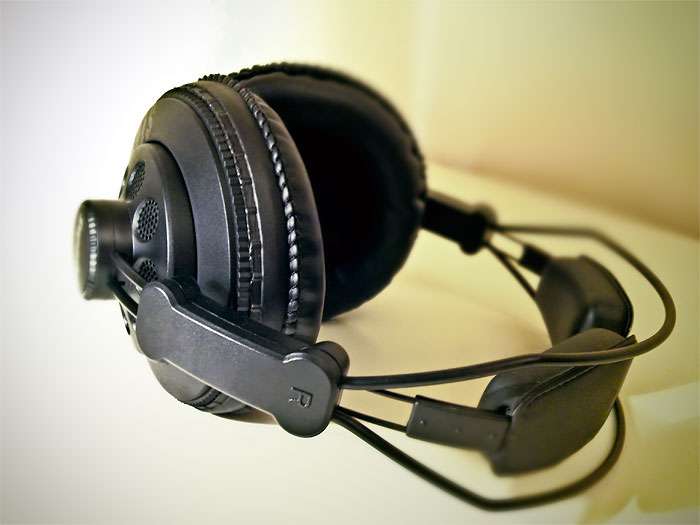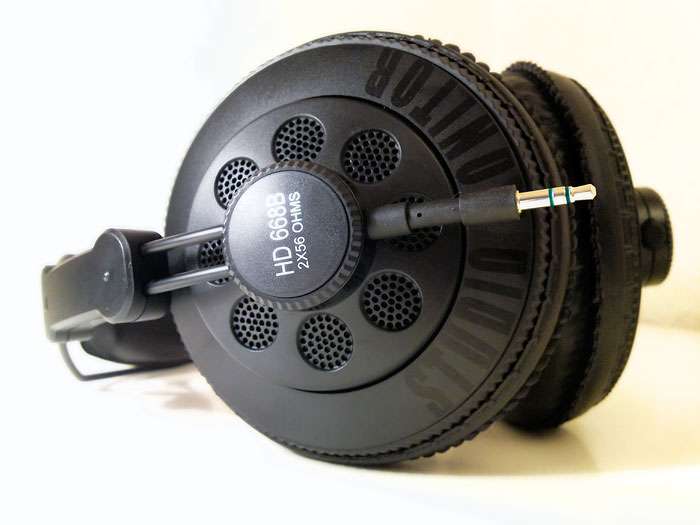EDIT 15.04.2014: A few months ago the Superlux HD-668B broke apart. I was cleaning it and apparently I applied too much force with the result that one of the earcups deattached itself from the headband. Replacement parts? They don´t exist. And I wouldn´t want to repair it. Why? Read on. Please note, that I updated this article slightly. It was too long (still is), badly written and contained wrong informations. I´ve therefore erased or replaced some parts with shorter and more realistic sentences. Also read my reviews about the Sennheiser Momentum, Skullcandy Aviator and the Sennheiser HD-558.
Introduction
Today I´d like to introduce you to a headphone. You might ask "Why do we even need a headphone?" which is a valid question, dear constant reader. So light a cigarette, prepare a cup of coffee and let me explain before I´ll start with my review.
HRTF (head related transfer function) & frequency response
Ready? Well, here it goes: headphones present the
most unrealistic sound you can experience. Loudspeakers play the music from in front
of you, mimicking a true stage presence while headphones project sound from
either side of your head directly into your ears. With loudspeakers therefore
you will experience something like a more or less realistic soundstage. Reason: we have only two ears but we can perceive music in three
dimensions nonetheless (distance, above or below, front or rear and left/right
sides). This process is called HRTF (Head-related Transfer Function) and it is
made possible because our brain, our inner ear and outer ear work together to
make interferences about the location. Our outer ear is very important, as is
the room where our loudspeakers are standing, our shoulders etc. The mixture of
direct sound & sound reflections creates the noise we
perceive as holographic sound - or music - from our loudspeakers. When these circumstances are perfectly aligned, the music will
"de-attach" itself from the loudspeakers, we literally are surrounded
by it, we can even pinpoint certain instruments or persons inside this artificial
sound cloud. This is also known as the "sweet spot". Yes, this can happen with stereophonic music, you won´t even
need surround for it. While this sounds wonderful the typical everyday situation or setup looks
a bit different instead: badly designed loudspeakers, the left loudspeaker stands in
the corner of the room while the right one stands free, etc.... just one of
these things can be enough to destroy the illusion of holographic sound.
Headphones are different. A headphone consists of two
loudspeakers; one sitting directly on your left ear, the other one on your
right ear. As you can imagine this excludes sound that is approaching our ears
through the room, passing our shoulders etc. These two loudspeakers project
sound directly into our earlobes which creates a perfect "sweet
spot" since all possible imperfections coming from playback via
loudspeakers are removed. This sounds good, doesn´t it? But wait: Our ear
needs the particular situation of loudspeakers standing in front of us, it needs the sound reflections to be able to reference a location. If this situation is removed we get
the - headphone typical - "sound in our head", the sweet spot is too perfect. Furthermore, through
bodily felt bass frequencies from loudspeakers we literally feel music - with
headphones this is confined to our head only, it removes the bodily sensations.
And the most important point is that music is engineered by mixing engineers to be used
on loudspeakers only, very few are mixing via headphones. So only music played back via
loudspeakers represents true stereo sound. With headphones you get two mono
channels instead. Some headphone
amplifiers aim to circumvent this "sound in your head" effect by
using a so called "Crossfeed-Filter" (there are some very handy components
for foobar2000 and many other media players available).
I´d like to tell you about a
little french study from the '80s that headphone manufacturers are seldomly mentioning: this particular study concludes that using a well constructed headphone
and a good, digital equalizer you can mimic the sound of other headphones. The
contestants of this study couldn´t differentiate between the original headphone
and the one that recreated this sound on another headphone with the help of an
equalizer. Example: I own a Sennheiser HD-600, 15 years ago the
best product Sennheiser had to offer. It became instantly famous for its very
spacious, balanced, refined and detailed sound. A few years later Sennheiser
created a follow-up model, the Sennheiser HD-650. The newer model tried to
combine the treats of my HD-600 with a warmer sound signature and it was of course
more expensive. But just two days ago I recreated the sound of the HD-650 with
my HD-600, I did it very easily with a digital equalizer and I only glanced at
the differences of their various frequency responses - look below. The sound of
a headphone basically comes down to this: how it is constructed (open,
semi-open or closed), supra aural (on your ear) vs. circumaural (around your
ear), electrical resistance and frequency response. When one knows this, one
can easily construct different models which sound alike. There are some more things important
to headphone construction of course, but this would crash this already very long article.
Overview
So a few months ago in a discussion over at hydrogenaudio I stumbled upon the description of a headphone, the Superlux HD-668 B. Never heard of it? Well, I´d wonder if you actually did. Superlux is a taiwanese manufacturer for OEM products and some time ago they decided to produce some things under their own name. One of these things are headphones. The particular model I´d like to write about is a headphone that is aimed for use in studio environments. Very suspiciously it looks like a classic model from AKG: the K-240, a headphone that was used for a long time and very often at recording studios. It gets even better: the frequency response of the Superlux HD-668 B aims to reproduce the sound of a particular, much more expensive headphone from German manufacturer Beyerdynamic: the DT990 which itself is a classic amongst headphones. In general headphones from Beyerdynamic are famous for their distinct sound signature: analytic, brilliant, dynamic, tremendous bass & a bit cold. Very different from my Sennheiser which is exemplary of the Sennheiser sound: laid back, detailed, with good clarity and extremely balanced (critics used to crisper sounding headphones often speak of the "Sennheiser veil"). While I´m very happy with my Sennheisers I always wanted to own an example of the typical Beyerdynamic sound but couldn´t afford to because of the steep price - until now when I finally was able to do so. Because believe it or not: while the Beyerdynamic DT990 costs 299,- Euros the Superlux HD-668 B costs only 30,- Euros.
 |
| Actual frequency response differences as measured by HeadRoom. Apart from missing deep bass remarkably similar. |
I couldn´t believe this price myself so I did a lot of reading before I decided to purchase it. Every review I´ve read pointed out how great this headphone sounds, the sound was praised as Beyerdynamic like, several persons even commented that it actually sounds a tad better than the Beyerdynamic headphone. Please remember that we are talking about comparisons where one headphone costs 10 % of the price of the other one! Ever the doubter, I thought "Nah, they are talking bullshit, this can´t be". Out of curiousness I ordered one to find out myself... 30,- Euros doesn´t hurt that much, don´t you think? The Superlux HD-668 B came in a nice box made out of cardboard. Inside the box I found two headphone cables, one 3 meter long, the other one 1 meter long. The short one is for portable use, the long one for home use. You can even combine them to form a four meter long cable. The Superlux weighs 222 g and bears two self adjusting headband pads. I also found an adaptor from 3.5 mm to 6.3 mm stereo jack (every adaptor is gold plated). The plastic material looked sturdy - not beautiful but precisely manufactured as you can see on the pictures. The ear cushions were relatively thick and made out of pleather. Superlux even managed to include a manual in German language! All in all, this company offers much material for very little money.
Sound
Well, how does it sound? Erm... it sounds gorgeous, simply gorgeous. For a certain kind of people. It presents music as promised: very different to my Sennheiser yet fairly decent and with another sound signature. Let me elaborate: remember that I wrote about HRTF up above? So my constant reader, you´ll remember that we have the most natural sound only with loudspeakers but not with headphones. But here´s a twist because the clever diva that I am didn´t mention that there is an exception: binaural recordings. The principle is easy - you place a dummy head at the place where you want to record sounds, you form some earlobes mimicking the ones we humans posess and inside those earlobes you place two tiny microphones. Due to the form of the earlobes, the sound will hit the microphones the same way as the "real" sound would hit our ear if we were there ourselves. Result: the information how the room sounds will be recorded - in theory playing such a recording back via headphones will produce exactly the same stage impression as present during the recording - the sound will literally play "outside our head" - behind us, above us, in front of us. But only well constructed headphones reproduce the effect convincingly; if they distort the sound or if their housing creates resonances the effect is destroyed.
But not the Superlux, the Superlux made everything perfect.
While I noticed a slight "plastic-y" sound, the stage impression was
wonderful. You don´t own any binaural recordings? Well, try some
multichannel material and decode it with Dolby Headphone - same principle. So
the Superlux passed my first listening test convingly. Though there still was the issue with that plasticky sound and I wanted to find out if that was true with normal recordings also - so I turned to some SACD
recordings I made some time ago. The first thing I noticed that the Superlux sounded very crisp. At the same time, I was surprised that the bass was fairly strong (especially upper bass). Apart from the bass it sounded very forward at the presence area, it was almost unflattering to listen to the music
because it sounded so harsh and sterile, even on recordings where I knew for certain that
they wouldn´t sound that way. In short, I feared that it would sound like that all the
time which would have been an awful disappointment after I expected it to sound well from all the positive reviews I´ve read. But I had a slight suspicion: new headphones are not played in, their
drivers may need some time to "loosen up", much the same as new
loudspeakers. So I played a burn-in signal of mine for several hours. Quite unnerving... but worth it. Because afterwards the plasticky sound was almost gone,
violins got more silky, the sound was less "in your face" and less brittle. It simply got more
balanced.
Still, compared to my Sennheiser the Superlux sounded as if it wasn´t able to differentiate as much, it sounded less refined and much more "hissy". The Superlux
presented music detailed and way too crisp - you could hear every
error in the recording in an unflattering way. My Sennheiser manages the same feat - without sounding piercing or brittle. Also, without binaural recordings I had the feeling that
the soundstage appeared to be flatter compared to my Sennheiser. An additional problem was that they began
to hurt my head after wearing them for only a few minutes, the pleather
ear cushions caused my skin to sweat immediately.
Modding
But hooray, for every malady there is a solution. The
easiest one involved bending the headband so that it would fit my head better -
gone was the painful pressure. Another solution involved playing my burn-in
signal again and for longer periods, I found that this "loosened" up the sound
even further, made it less constricted. To improve the soundstage I placed rolled-up paper
tissue between housing and ear cushions so that my ear lobes would fit behind
the ear cushions and I would be able to move the headphone more to the front
of my head and a bit down (try this with your own headphone - you may be surprised how much the soundstage improves). But the best thing I did was to purchase different ear cushions. Since this headphone looks like an AKG K-240 several people
figured that their ear pads would also fit on the Superlux headphones. As it turns
out those people were right: I spent another 17,- Euros for AKG ear cushions
made out of soft velour to replace the pleather ear pads from Superlux. And I
don´t know why, but after that the sound changed considerably: it became
more balanced, the soundstage got deeper and the problem with differentiation
disappeared. Now the headphone sits easy on the head, is very
comfortable and sounds wonderful.
EDIT 15.04.2014: Gosh, what a bad review this is! The Superlux might be more pleasant this way but it still is a headphone with recessed mids, almost no deep bass and piercing treble. The treble is the most unpleasant thing about the HD-668B because it´s harsh, hard, brittle and extremely piercing.
EDIT 15.04.2014: Gosh, what a bad review this is! The Superlux might be more pleasant this way but it still is a headphone with recessed mids, almost no deep bass and piercing treble. The treble is the most unpleasant thing about the HD-668B because it´s harsh, hard, brittle and extremely piercing.
The
Superlux with the AKG earpads.
As you can see my Sennheiser has a very high impedance of
roughly 600 Ohms at bass frequencies while it stays relatively flat at the rest
with 300 Ohms. When you plug it into an amplifier that has an output impedance
of, say, 600 Ohms this will result in a sound with way too much bass. To say it simple: if the output impedance of the headphone amp would be just one Ohm then the
amplifier would have more "control" over the headphone and the
amplification of the bass area wouldn´t happen. As a general rule it is safe to
say that a headphone needs an impedance eight times that of the amp´s output.
EDIT 15.04.2014: This rule doesn´t apply to the HD-668B however; it´s easily driven by almost any headphone output without too much frequency distortion caused by impedance mismatch problems. Also, I´ve erased some parts of this article. I wrote for hours and hours about how the Superlux profits from being amped by our Lenovo SL-510 yet sounded like crap when amped by the E-MU 0202 USB and my ASUS Xonar Essence ST. It was all wrong: the Superlux doesn´t react to impedance mismatches. The piercing treble and recessed mids is its natural sound signature. Using it with the Lenovo simply created a random synergy effect; the headphone output of the SL-510 sounds very, very muffled. Of course, that´s benefitial for the piercing treble of the Superlux. But plug it into the electrically perfectly behaving FiiO E06 or the FiiO E07K, extract the 'true' sound of the Superlux... and you´ll run away screaming. The sound of the Superlux HD-668B is teeth-rattling and headache inducing.
EDIT 15.04.2014: This rule doesn´t apply to the HD-668B however; it´s easily driven by almost any headphone output without too much frequency distortion caused by impedance mismatch problems. Also, I´ve erased some parts of this article. I wrote for hours and hours about how the Superlux profits from being amped by our Lenovo SL-510 yet sounded like crap when amped by the E-MU 0202 USB and my ASUS Xonar Essence ST. It was all wrong: the Superlux doesn´t react to impedance mismatches. The piercing treble and recessed mids is its natural sound signature. Using it with the Lenovo simply created a random synergy effect; the headphone output of the SL-510 sounds very, very muffled. Of course, that´s benefitial for the piercing treble of the Superlux. But plug it into the electrically perfectly behaving FiiO E06 or the FiiO E07K, extract the 'true' sound of the Superlux... and you´ll run away screaming. The sound of the Superlux HD-668B is teeth-rattling and headache inducing.
Conclusion, edited 15.04.2014
I cannot recommend it anymore. Did you buy it because of my recommendation? If so, I´m very, very sorry. Don´t get me wrong: the Superlux HD-668B is not a bad headphone. Considering its price, it sounds well. If you can accept almost no deep bass, recessed mids and the über-piercing treble. Just like the Beyerdynamic DT990 it is a higly 'sounded' headphone, featuring a signature appealing to people not minding imbalanced sound. Headphone sound is diffificult... for one person this sound is bliss, for another person it´s Hell. For me it´s the latter. Add to that the not-so-good reliability of the Superlux. When I was cleaning it, it broke apart. Replacement parts are not available, I´d have to search for a used model. Or I could simply buy a new one. But I will not, it´s just not my cup of tea.
Last update: 15.04.2014










wow :)
ReplyDeleteVery nice and informative review. Thank you.
ReplyDeleteCan you upload your burn-in signal? I'd like to burn my Superlux too, I tried standard tracks but this is not working that quickly.
ReplyDeleteMy burn-in signal is not that special. You can do it yourself: create whitenoise and mix it with frequency sweeps, that´s what I did. And uploading would be impossible since it´s in 24/192, 15 minutes long & roughly 750 MB big.
DeleteI suggest this site where you can download every type of burn-in you can ever think of: http://treoo.com/blog/category/guides-tutorials/how-to-burn-in
too bad it broke when you clean it, well buy a new one, its not that expensive with "sound that expensive". Or you can use another headphone part like AKG240 if you like.
ReplyDeleteIn My experience this headphone is really hard to break, unless you meant to (step on it, run over with car), i mod it here and there to my liking, improving it FR, and so far it is my favorite headphone.
I own ATH M50, Beats Studio, apple earpod, even balance armature MEElectronic A161. Subjectively i like this headphone and MEElectronic. So Does other close friends who never use good headphone when auditioning, the like HD668B more than my other headphone, especially when playing good music, even movies. HD668B tend to give accurate acoustic ambience and positioning. Good for Horror movies, it successfully give people "jump" when there's sudden pop on steam in dark corridor...
I don´t intend to buy it again, it just wasn´t my cup of tea. Took me a bit to find that out. And even though spatial imaging is pretty good I cannot ignore the abrasiveness / harshness of the treble area and that mids are too weak. Last year, I replaced it with an ATH M50x and just yesterday I bought a used Sony MDR-CD 550 which was my first "big" headphone. Should I ever find the time to write new reviews, I will talk about both :)
DeleteI own HD-668B for a couple of years (with AKG cushions - bought it following your review) and I don't regret it at all. It sounds much better than anything I had before (which were all cheap consumer models). So thank you for your advice and sorry to hear you got disappointed with HD-668B later.
ReplyDeleteEmmmm....seems like you broke it and somehow became mad at it and all blame it for all the mishaps ...kinda funny.anyhow...good laughing...thanks.
ReplyDeleteNot really. I disliked it before (it just isn't balanced enough). I wanted to give it to a friend and upon cleaning it, it broke. I didn't get angry at it, I was just disappointed: devices have to be cleaned once in a while, especially headphones. Cleaning shouldn't break them, as simple as that.
Delete